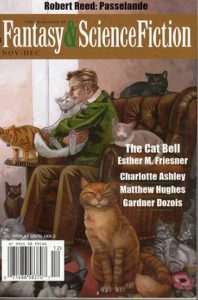The Magazine of Fantasy & Science Fiction Nov/Dec 2016 edited by C.C. Finlay
The Magazine of Fantasy & Science Fiction started publication in 1949. According to Wikipedia, it was supposed to be a fantasy story version of Ellery Queen Mystery Magazine as it was at the time, classic reprints mixed with new material of a higher literary quality than was common in the pulps of the time. Science fiction was added to expand the possible pool of stories. F&SF has managed to publish fairly regularly ever since, though in recent years it’s bimonthly. It has a reputation for literate fiction.
The cover story is “The Cat Bell” by Esther M. Friesner. Mr. Ferguson is a successful actor in the early Twentieth Century, even having a fine house with servants. One of those servants, Cook, greatly admires Mr. Ferguson. Mr. Ferguson greatly admires cats, and has nineteen of them that Cook must feed every day. One day there are twenty cats, and Cook finds herself in a fairy tale. Content note: Cook suffers from several of the less pleasant “isms” and isn’t afraid to say so.
“The Farmboy” by Albert E. Cowdrey is set on a distant planet being surveyed by a scout ship. The crew has discovered a massive deposit of gold, but even if they had room to take it with them, the government would simply confiscate the wealth, giving nothing to the survey crew. Several of the crew members come up with a scheme to make themselves very rich at the expense of the rest of the crew. But if you can’t spot the sucker at the poker game, it’s probably you…some unpleasant sexism.
“Between Going and Staying” by Lilliam Rivera takes place in a future Mexico even more dominated by the drug cartels. Dolores is a professional mourner using the newest bodysuit technology. She’s been making very good money performing for the wealthy, but this funeral is personal.
There are two book review columns, one by Charles de Lint, in which he admits not being fond of psychological horror. The other is by Chris Moriarty and focuses on books about human survival.
“The Vindicator” by Matthew Hughes is the last story in his current cycle about Raffalon the thief. Raffalon is a mediocre burglar in the sort of fantasy city that has a Thieves’ Guild. For some reason a Vindicator (assassin) is after Raffalon, and the Vindicator’s Guild isn’t being helpful for calling it off. Raffalon hires a Discriminator (private investigator) and the truth turns out to be explosive.
A relatively rare Gardner Dozois story follows, “The Place of Bones.” A scholar and his companion discover the Dragonlands, where dragons go to die. More of a mood piece than a proper story.
“Lord Elgin at the Acropolis” by Minsoo Kang involves a police officer and writer meeting to consider the problem of a museum director who believes that one of the paintings in the museum is fake, despite no other evidence. Is he just crazy, or is there another explanation?
“Special Collections” by Kurt Fawver is a horror story about a library with a section you must never enter alone, which is the first rule. And then there’s the second rule….
David J. Skal reviews High-Rise for the film section, and compares it to the J.G. Ballard novel.
There’s the results of a contest for updating older science fiction works to today’s world. Including a “Dishonorable Mention” update of 1984.
“A Fine Balance” by Charlotte Ashley is set in a city where all disputes between the two major parties are settled by specially trained duelists. Except that one side doesn’t want to play by those rules any more. Very satisfying story.
“Passelande” by Robert Reed takes place in a depressing near future with electronic backups for people who can afford them. Backups who have their own feelings and motivations. This one grated on me, as I felt the characters had their motivations poorly explained/depicted.
“The Rhythm Man” by James Beamon is a variant on the legend about talented musicians selling their souls for skill or fame. A lot of set-up for one great scene at the end.
And the stories wrap up with “Merry Christmas from All of Us to All of You” by Sandra McDonald. It’s a dystopian tale of a gift-making community that ensures none of its children can truly escape. But perhaps there is a ray of hope?
There’s an “Easter egg” in the classified ads, and then an index of stories and features that appeared in 2016’s issues.
I liked “The Vindicator” and “A Fine Balance” best, though “The Cat Bell” was also quite entertaining. “Passendale” was the weakest story for me.
This magazine has consistently high quality stories and some nice cartoons; consider a print or Kindle subscription.

